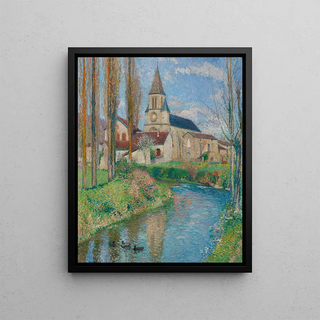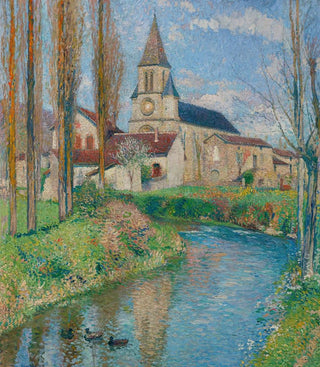Art print | Église de Labastide-du-Vert - Henri Martin


View from behind

Frame (optional)
Henri Martin's work "Église de Labastide-du-Vert" is an invitation to immerse oneself in the colorful and poetic universe of the late 19th century. Through this depiction, the artist transports us to a rural landscape where serenity and the beauty of the surroundings intertwine. The soft light bathing the church, along with the delicate nuances of the sky and the surrounding vegetation, create an almost dreamlike atmosphere. This piece, which evokes both spirituality and the tranquility of village life, is a true ode to nature and the harmony that can emanate from it. Contemplating this art print, the viewer is invited to feel the breath of passing time while admiring the artist's technical mastery.
Style and uniqueness of the work
Henri Martin, an emblematic figure of the post-impressionist movement, stands out for his bold use of color and light. In "Église de Labastide-du-Vert," he deploys a rich and vibrant palette that gives the work striking depth and texture. The brushstrokes, both precise and free, testify to an ongoing quest for beauty in everyday life. The choice to depict a church, a symbol of faith and community, within a natural setting emphasizes the interconnectedness between man and his environment. Every detail, from the leaves of the trees to the stones of the church, is treated with care, revealing a particular attention to reality while leaving room for personal interpretation. This art print is distinguished by its ability to capture the essence of a fleeting moment, inviting the viewer to dive into it and find their own echo.
The artist and his influence
Henri Martin is often regarded as one of the masters of French painting, whose work was marked by a quest for light and color. Influenced by artists such as Claude Monet and Paul Cézanne, he developed a style that is uniquely his own, blending realism and impressionism. His career, marked by success, allowed him to explore various themes, ranging from landscapes to scenes of daily life. Martin was also a

Matte finish

View from behind

Frame (optional)
Henri Martin's work "Église de Labastide-du-Vert" is an invitation to immerse oneself in the colorful and poetic universe of the late 19th century. Through this depiction, the artist transports us to a rural landscape where serenity and the beauty of the surroundings intertwine. The soft light bathing the church, along with the delicate nuances of the sky and the surrounding vegetation, create an almost dreamlike atmosphere. This piece, which evokes both spirituality and the tranquility of village life, is a true ode to nature and the harmony that can emanate from it. Contemplating this art print, the viewer is invited to feel the breath of passing time while admiring the artist's technical mastery.
Style and uniqueness of the work
Henri Martin, an emblematic figure of the post-impressionist movement, stands out for his bold use of color and light. In "Église de Labastide-du-Vert," he deploys a rich and vibrant palette that gives the work striking depth and texture. The brushstrokes, both precise and free, testify to an ongoing quest for beauty in everyday life. The choice to depict a church, a symbol of faith and community, within a natural setting emphasizes the interconnectedness between man and his environment. Every detail, from the leaves of the trees to the stones of the church, is treated with care, revealing a particular attention to reality while leaving room for personal interpretation. This art print is distinguished by its ability to capture the essence of a fleeting moment, inviting the viewer to dive into it and find their own echo.
The artist and his influence
Henri Martin is often regarded as one of the masters of French painting, whose work was marked by a quest for light and color. Influenced by artists such as Claude Monet and Paul Cézanne, he developed a style that is uniquely his own, blending realism and impressionism. His career, marked by success, allowed him to explore various themes, ranging from landscapes to scenes of daily life. Martin was also a






